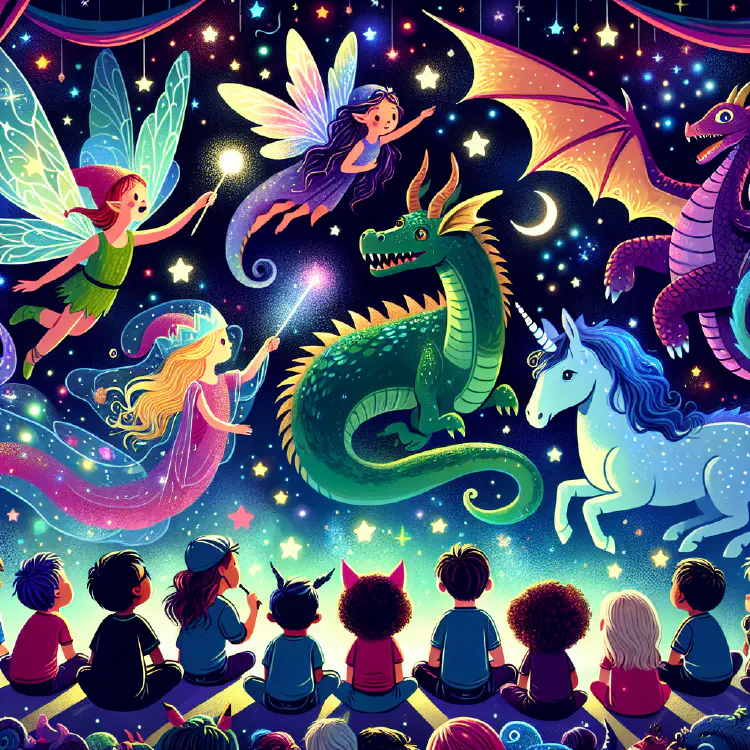The Role of Magical Creatures in Bedtime Tales
Magical creatures in bedtime stories captivate children's imaginations, teach valuable lessons, and enhance language development while fostering a love for storytelling.
- 4 min read

Bedtime stories have been a cherished tradition for generations, captivating the imaginations of children and helping them drift off to sleep with dreams of fantastical worlds and enchanting characters. Among the most beloved elements of these tales are the magical creatures that inhabit them. From mischievous fairies to wise dragons, these mythical beings play a crucial role in creating memorable bedtime stories for kids. In this blog post, we’ll explore the importance of magical creatures in bedtime tales and how they contribute to children’s development and love for storytelling.
The Magic of Bedtime Stories
Before we delve into the world of magical creatures, let’s first understand why bedtime stories are so important for children. Bedtime stories for preschoolers and toddlers serve multiple purposes:
Bonding time: Reading bedtime stories allows parents and children to spend quality time together, strengthening their emotional connection.
Language development: Exposure to new vocabulary and sentence structures helps children improve their language skills.
Imagination stimulation: Stories encourage children to use their imagination and think creatively.
Relaxation: A soothing bedtime story can help children wind down and prepare for sleep.
Moral lessons: Many bedtime short stories contain valuable life lessons and moral teachings.
Now that we understand the significance of bedtime stories, let’s explore how magical creatures enhance these benefits and make bedtime tales even more captivating for young listeners.
The Allure of Magical Creatures
Magical creatures have been a staple of folklore, myths, and legends for centuries. Their enduring popularity in bedtime stories can be attributed to several factors:
Escapism: Magical creatures transport children to fantastical worlds, offering an escape from the everyday and igniting their imagination.
Wonder and awe: These beings possess extraordinary abilities that fascinate children and inspire a sense of wonder about the world around them.
Emotional connection: Many magical creatures are anthropomorphized, allowing children to relate to their feelings and experiences.
Symbolism: Magical creatures often represent abstract concepts or human traits, helping children understand complex ideas in a more accessible way.
Cultural significance: Many magical creatures are rooted in various cultures’ folklore, introducing children to diverse traditions and beliefs.
Popular Magical Creatures in Bedtime Stories
Let’s explore some of the most beloved magical creatures that frequently appear in bedtime stories for kids and the roles they typically play:
- Fairies
Fairies are perhaps the most iconic magical creatures in children’s literature. These tiny, winged beings are often portrayed as mischievous but kind-hearted creatures with magical powers. In bedtime stories, fairies can serve various purposes:
- Granting wishes
- Helping children overcome challenges
- Teaching valuable lessons about kindness and generosity
- Introducing the concept of magic and wonder
Example: “The Tooth Fairy” is a popular bedtime story that features a fairy who collects children’s lost teeth and leaves a small gift in return.
- Dragons
Dragons have captivated human imagination for millennia. In bedtime stories, dragons can be portrayed as either fearsome adversaries or wise, benevolent creatures. Their roles in stories often include:
- Guarding treasure or magical objects
- Representing challenges to be overcome
- Imparting ancient wisdom
- Teaching lessons about courage and understanding
Example: “The Paper Bag Princess” by Robert Munsch features a clever princess who outsmarts a dragon, subverting traditional fairy tale tropes.
- Unicorns
Unicorns are magical horses with a single horn on their forehead, often associated with purity and innocence. In bedtime stories, unicorns frequently:
- Symbolize hope and dreams
- Possess healing powers
- Teach lessons about believing in oneself
- Represent the beauty and magic of nature
Example: “The Last Unicorn” by Peter S. Beagle, while not a traditional bedtime story, has inspired many shorter tales featuring these majestic creatures.
- Mermaids and Mermen
These aquatic beings with human upper bodies and fish-like tails have long been a source of fascination. In bedtime stories, merfolk often:
- Introduce children to the wonders of the ocean
- Teach lessons about environmental conservation
- Explore themes of belonging and acceptance
- Showcase the beauty of underwater worlds
Example: Hans Christian Andersen’s “The Little
